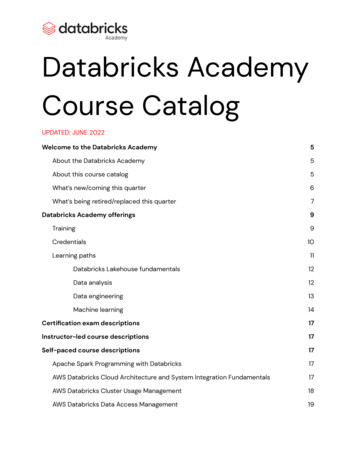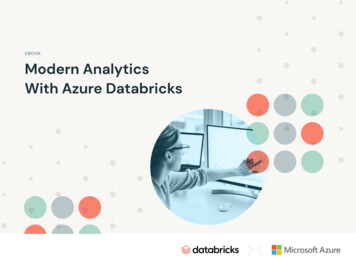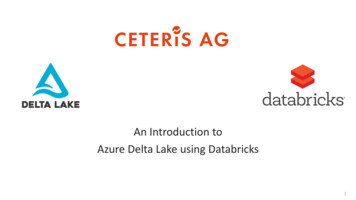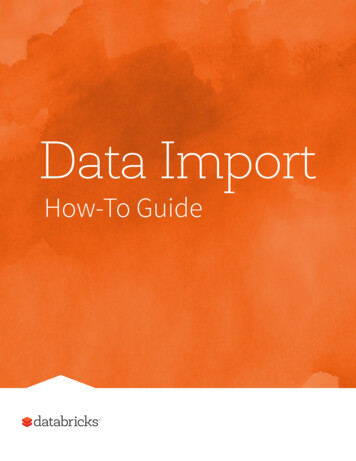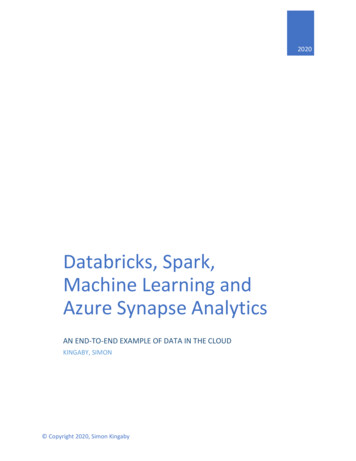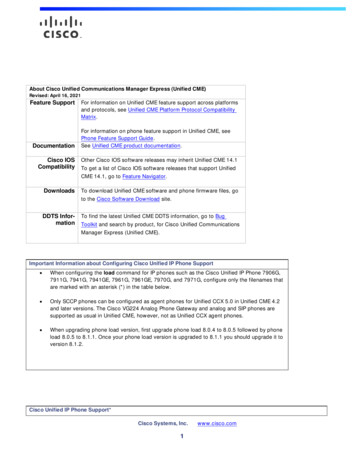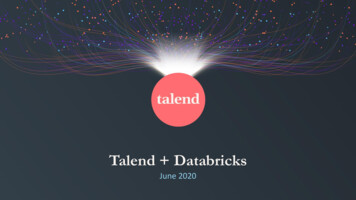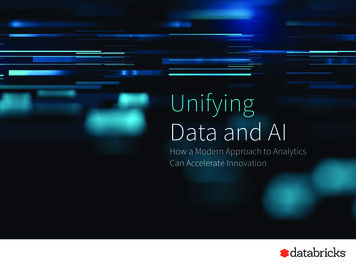
Transcription
UnifyingData and AIHow a Modern Approach to AnalyticsCan Accelerate Innovation
IntroductionThe world has come a long way since the early days of data analysis where a simple relational database, point-in-time data, and some internalspreadsheet expertise helped to drive business decisions. Today, enterprises are focusing massive amounts of resources to transform their businessthrough machine learning and automation. This allows them to drive competitive advantage, improve customer experience, and more efficientlymanage cost. According to a recent survey with CIO.com, nearly 90% of enterprises are investing in AI related technology.*Data is at the core of how these modern enterprises are changing their business. With this data, enterprises are able to tap into the promise of AIto drive disruptive innovations affecting nearly every enterprises on the planet. The challenge most enterprises face is how to succeed with boththeir data and AI?* https://databricks.com/cio-survey-report2
ChallengesData is Difficult to PrepareWe all know data is the key to success in today’s digital age. That’s whyenterprises are modernizing their data architectures — moving awayfrom legacy systems that are complex to manage and lack the flexibilityfor new data sources and advanced analytics. The core of this migrationis the data. However, preparing data for AI is a major bottleneck. In fact,96% of enterprises cite data related challenges as the #1 blocker to thesuccess of AI projects. Enterprise data is often siloed across hundreds ofsystems such as data warehouses, data lakes, databases and file systemsthat are not AI-enabled. This results in an enormous amount of time isData is Key to Success,But Difficult to Harnessspent combining, cleaning and verifying, enriching, and featurizing thedata to get it ready for the model. Furthermore, the need to managestreaming datasets (such as IoT and social) along with historical data forreal-time analytics increases this complexity even more.Underscoring this trend, 87% of enterprises are investing in technologyto help with data preparation and exploration.* This work required fordownstream analytics and AI is putting increasing demand on dataengineering teams to enable the business with high quality datasetswhile keeping costs low, data secure, and complex data pipelinesperformant and reliable.of enterprises investing intechnology for data preparationand exploration* https://databricks.com/cio-survey-report3
ChallengesSiloed Teams Hinder Productivity and Time to MarketThe productivity of the team structure across a data organization canbe severely impacted without a seamless and dependable and unifieddata strategy. It is very difficult for the siloed functional roles of datascientist, machine learning engineer, data engineer, and developer toachieve synergy and work together.Studies show that 90% of enterprises cite challenges with dataengineering and data science collaboration as a reason for theirinability to succeed with AI.* This organizational separation createsfriction and slows projects down, becoming an impediment to thehighly iterative nature of AI projects.Disjointed Data and AI TechnologiesThere has been an explosion of AI technologies like TensorFlow, PyTorch, and80%cite collaborationas a challengeSciKit-Learn which are great at enabling AI capabilities but don’t have the dataprocessing capabilities necessary to bridge the gap between data engineeringand data science. As a result, the capacity to feed data necessary to train amodel requires multiple handoffs that open the door for errors and inefficiency.Access to data is limited without a seamless integration between data and AItechnologies.Technology and skills gaps are the largest barriers to collaboration betweendata engineering and data science teams.* Organizations are burdened withthe limitations and complexity of setting up and maintaining distributedmachine learning environments due to a multitude of point solutions andinterdependencies between them. On average, large enterprises are using up toseven different tools for data engineering and data science.** https://databricks.com/cio-survey-report4
ChallengesBeyond the myriad of tools at their disposal, data scientists andmachine learning engineers are increasingly pressured to improveoverall productivity to reduce the time needed to train sophisticatedmodels. But the lack of highly specialized skills required to work withAn Explosion of Machine LearningFrameworks Adds Complexitythese AI technologies dramatically slows down projects and the abilityto get to results.Organizations areusing an average ofdifferent machine learningtools and frameworks5
ChallengesInfrastructure Complexity, Security andCompliance NeedsAs enterprises cope with rapidly growing volumes of data fromvarious data sources, costs and operational complexity canquickly get out of control. Organizations that have not movedto the cloud and are reliant on on-premises infrastructureexperience this pain tenfold as they often lack the abilityto quickly and easily provision resources to meet businessneeds, slowing their ability to respond to demand faster, whilestruggling to maintain costs.Further complicating matters, the fragmented technologyset supporting the AI lifecycle and the increasing number ofendpoints that needs to be secured makes it extremely hard forsecurity stakeholders to protect one of the most valuable assetsof the enterprise — its data.6
The Need for a Unified ApproachWith so many data challenges facing enterprises, that act as an impediment toinnovation, distracting the teams from their core competencies and increasing time to “ We cannot solve our problems with thesame level of thinking that created them.— Albert Einsteinmarket for new products and insights, a new approach needs to be considered.”With data as the fuel for AI innovation, the modern enterprise requires acomprehensive, unified approach to analytics and AI. Over 79% of enterprises highlyvalue the notion of a unified approach to analytics — bringing together data and AI,while enabling better collaboration and streamlining analytic workflows.*A unified approach to analytics makes it easier for enterprises to build data pipelinesacross various siloed data storage systems and to prepare datasets for model building,which allows organizations to do AI on their existing data and iteratively do AI onmassive data sets. Organizations also gain the benefit of integrating with a broad set ofAI algorithms that can be applied to these datasets iteratively to fine-tune the models.Lastly, unifying analytics improves collaboration across data scientists anddata engineers — empowering them to work more effectively across the entireexperimentation-to-production lifecycle. The organizations that succeed in unifyingtheir data at scale and unifying that data with the best AI technologies will be the onesthat succeed with AI.Databricks, powered by Apache Spark , provides a Unified Analytics Platform thatenables organizations to accelerate innovation by unifying data and AI technologies,improving collaboration between data engineers and data scientists, and making itsimpler to prepare data, train models, and deploy them into production.* https://databricks.com/cio-survey-report7
The Databricks AdvantageApache Spark — The Unified Analytics EngineTo avoid the problems associated with siloed data and disparate systems for handling differentanalytic processes, enterprises are increasingly using Apache Spark. Spark, originally created bythe founders of Databricks, is the defacto standard for data processing and AI today due to itsrecord-breaking speed, ease of use, and support for sophisticated analytics.Spark simplifies data preparation for AI by unifying data at massive scale across variousThe Rapid Ascension of Apache Sparksources including cloud storage systems, distributed file systems, key-value stores, and Created at UC Berkeley in 2009 by Matei Zaharia.message buses. Spark also unifies data and AI with a consistent set of APIs for simple Replaced MapReduce as the de facto data processingdata loading, batch/stream processing, SQL analytics, stream analytics, graph analytics,machine learning, and deep learning as well as seamless integration with popular AIframeworks and libraries such as TensorFlow, PyTorch, R and SciKit-Learn.engine for big data analytics. Includes libraries for SQL, streaming, machine learningand graph. Largest open source community in big data(1200 contributors from 300 orgs). Trusted by some of the largest enterprises(Netflix, Yahoo, Facebook, eBay, Alibaba). Databricks continues to drive most major efforts:Structure in Spark, DataFrames, Catalyst, Tungstenand Structured Streaming. Over 425,000 meetup members around the world.8
The Databricks AdvantageUnify Data Engineers and Data ScientistsWith a unified approach to data and AI, data science teams can collaborate usingDatabricks’ collaborative workspace. They can use their preferred ML frameworks andlibraries to interact with the data they are modeling, and then seamlessly move those“ We chose Databricks over Hadoop-based alternatives because it is a unified cloud-models into production with a single click.based big data processing platform that isSupport for SQL, R, Python, Java, and Scala and seamless connection with popularbuilt on top of Apache Spark, combiningIDEs through native integrations, or BI tools with ODBC connections allows dataengineers and data scientists to use familiar languages and tools without the need tothe fast performance and standard librariesswitch working environments.of Spark with a user-friendly interface thatBy integrating and streamlining the individual elements that comprise the analyticsfosters collaboration across our teams.lifecycle, these teams can create short feedback loops and work together, creating a cultureof accelerated innovation. Now, thanks to Databricks it’s possible to build a model and testa prototype in hours vs weeks or months with older approaches.— Robert Ferguson, Director of Engineering,”Automatic LabsDatabricks provides a common interface and tooling for all stakeholders (data engineersand data scientists), regardless of skill set, to foster strong collaboration. This eliminatessilos and allows teams to collaborate across the AI lifecycle, from experimentation toproduction, which in turn benefits the organization and increases innovation.9
The Databricks AdvantageBuild Reliable and Performant Data PipelinesReliability is of utmost importance when dealing with critical workloads andBuilding best-in-class AI applications requires data, and a lot of it. Dataapplications. Databricks offers a 99.9% SLA through it’s fully managed cloudscience techniques that were actually developed years ago are only nowservice, as well as transactional guarantees with the Delta technology withinstarting to show promising results due to the sheer volume of data thatDatabricks Runtime, making real-time data accessible quickly for downstreamcan finally be used to train algorithms. And the faster you can ingest andanalytics and AI.prepare the data for analytics, the sooner you can realize the benefits of AI.Databricks has taken data processing performance to another level throughDatabricks Runtime. Databricks Runtime is built on top of Spark, nativelyfor the cloud.Our Spark expertise is a huge differentiator in ensuring superior performanceand very high reliability. These value added capabilities will increase yourperformance and reduce your TCO for managing Spark.Through various optimizations for large-scale data processing in the cloud,we’ve made Spark faster and more performant. Recent benchmarks clockDatabricks at a rate of 50x faster than Apache Spark on AWS — makingit simpler to build highly reliable data pipelines capable of processingmassive datasets at blazing speeds.“Databricks takes the pain out of cluster management, and puts the real power of these systems in the hands of those whoneed it most: developers, analyst, and data scientists are now freed up to think about business and technical problems.— Shaun ElliottTechnical Lead of Service Engineering, Edmunds.com”10
The Databricks AdvantageRUNTIME TOTAL ON 104 QUERIES (SECS — LOWER IS BETTER)SPARK ON DATABRICKSRUNTIME GEOMEAN ON 104 QUERIES (SECS — LOWER IS BETTER)SPARK ON DATABRICKS11,674SPARK ON AWSSPARK ON AWS53,78301500030000450007,981CLOUDERA IMPALA280 CORES37507500150003,331,4400SPARK ON .3PRESTO ON AWS27,77275000150RUNTIME GEOMEAN ON 62 QUERIES (SECS — LOWER IS BETTER)8,25901201,149,264CLOUDERA IMPALA11250PRESTO ON AWS80RUNTIME TOTAL ON 77 IMPALA QUERIES, NORMALIZED BY CPU CORES(CPU TIME— LOWER IS BETTER)RUNTIME TOTAL ON 62QUERIES (SECS — LOWER IS BETTER)SPARK ON DATABRICKS40SPARK ON DATABRICKS11,8980145.1060000RUNTIME TOTAL ON 77 IMPALA QUERIES (SECS — LOWER IS BETTER)SPARK ON DATABRICKS144 CORES35.53000029307515022530011
The Databricks AdvantageBuild Cutting-Edge AI Models at Massive ScaleWith Databricks, data science teams can leverage the Unified Analytics Platform to easilytrain, evaluate, and deploy more effective AI models to production. And to easily connectwith data sets to perform data exploration, analysis, and transformations using SQL, R,or Python. And interactively explore data with collaborative notebooks that allow datascientists to take machine learning models from experimentation-to-production at scale.And with prepackaged AI frameworks such as TensorFlow, Horovod, Keras, XGBoost, PyTorch,SciKit-Learn, MLlib, GraphX, and sparklyr, data science teams can easily provision AI-readyDatabricks clusters and notebooks in seconds on its cloud native service.Finally, the Databricks Unified Analytics Platform significantly simplifies parallelization anddistributed model training on CPU and GPU across cloud platforms via built-in optimizationfeatures and libraries (such as Horovod Estimator). It also natively decouples compute andstorage, reducing the need to move data and allowing significantly faster analysis on massiveamount of data at lower cost.12
The Databricks AdvantageReliability and Security in the CloudThe proliferation of siloed-data types and point solutions for data management (data lakes,data warehouse, and streaming) is increasing costs and operational complexity. Furtherexacerbating the problem is the inability of on-premises infrastructure to automaticallyscale resources to meet changing business needs. This leads to operational costs runningamok. Security also is a challenge as compliance standards such as HIPAA and GDPR areincreasing pressure on the business to keep data safe and secure.Reap the benefits of a fully managed service and remove the complexity of big data andmachine learning to focus more on innovation, while keeping data safe and secure.Databricks’ elastic cloud service is designed to reduce operational complexity whileensuring reliability and cost efficiency at scale, with a unified security model featuringfine-grained controls, data encryption, identity management, rigorous auditing, andsupport for compliance standards.Lowering the Total Cost of OwnershipDatabricks lowers TCO with a cloud native Unified Analytics Platform that means no costlyhardware, an operationally simple platform with built-in automation features designedto help you efficiently manage your costs, increased productivity through seamlesscollaboration, and faster performance than other analytics products which allows you toaccelerate AI innovation.13
Customer Proof Point: LoyaltyOneCompanySolutionLoyaltyOne, Inc. is a global provider of loyalty marketing and programs toDatabricks provides LoyaltyOne with a unified analytics platform that simplifiesenterprises in retail and financial services. AIR MILES is their flagship productand /accelerates ETL and empowers their data science organization to collaborateand Canada’s largest loyalty program that serves over 11 million households.via interactive notebooks to build, train and deploy machine learning models.Use CaseBusiness BenefitsTheir goal is to create a highly personalized experience that is optimizedLoyaltyOne realized the following benefits:for conversions for their partner retailers. They call it 1:1 Conversational Simplified infrastructure management — They don’t have to waste timeMarketing. Through machine learning and predictive analytics, they have builtself-learning offer optimizations that help partners deliver the right offer atthe right time to motivate customer behavior.Challenge Their legacy Netezza data warehouse did not allow them to process bothhistorical and real time data at scale, lacked the flexibility to easily handledifferent types of data, and impeded their ability to innovate and deliverprovisioning clusters. Self-service cluster management with auto-scale/auto-termination of clusters helped reduce costs and saved management effort. Improved collaboration — Notebooks made it much easier to share work.The interactive nature of the workspace enabled them to support multiple usertypes across the organization. As a result, they were able to increase offer response rate by 2x with a 97%improvement in speed.machine learning capabilities. They struggled with vast amounts of data across different formats — millionsof transactions from dozens of retailers, 100 partners, 500 million emails/year, 1200 campaigns/year, and 11 million households served. They also struggled to make Spark accessible to a large and diverse analyticsteam that had a range of skills and needs. Lastly, there was pressure to accelerate speed to market to satisfy theirpartners and their legacy system created complexity that slowed progress.“ Databricks has provided us with the support and technologyto modernize our architecture, enabling us to do data scienceat massive scale.”— Bradley Kent, AVP, Program Analytics at LoyaltyOne14
The Bottom LineThe goal of Databricks’ Unified Analytics Platform is toaccelerate innovation. It accomplishes this by uniting peoplearound a shared objective with a common collaborationinterface and self-service functionality. Additionally,Databricks unifies analytic workflows by seamlesslyconnecting operations and automating infrastructure —removing complexity for organizations and allowing them toinnovate faster than ever before.Get started on Databricks today with a free trial.START YOUR FREE TRIAL Databricks 2018. All rights reserved. Apache, Apache Spark, Spark and the Sparklogo are trademarks of the Apache Software Foundation. Privacy Policy Terms of Use15
comprehensive, unified approach to analytics and AI. Over 79% of enterprises highly value the notion of a unified approach to analytics — bringing together data and AI, while enabling better collaboration and streamlining analytic workflows.* A unified approach to analytics
